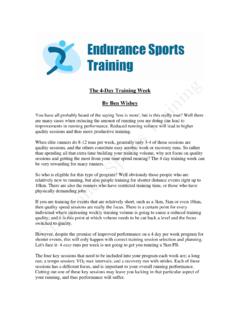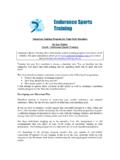Transcription of indusTri >> By Ben Wisbey What is EPOC?
1 indusTri >> what is EPOC? Excess post-exercise oxygen consumption (EPOC) is a physiological measure of the oxygen consumed in excess of resting requirement after exercise. It is measured in litres or ml/kg. EPOC reflects the disturbance of the body s homeostasis brought on by exercise, and the subsequent recovery demand. Exact measurement of EPOC is only possible by analysing respiratory gases with laboratory equipment. Practical limitations in conducting this type of testing have led to the development of methods to estimate EPOC based on heart rate. In this article, we will refer to predicted EPOC as pEPOC. How is pEPOC calculated? In order to make a prediction of EPOC, a known maximal heart rate and VO2 max for the user is required. The heart rate and heart rate variability (HRV) measurements during exercise are then used to predict respiratory rate and VO2. Predicted respiratory rate and VO2 are then used in conjunction with heart rate to predict EPOC.
2 what could pEPOC be used for?One of the key challenges in sport science is in determining an optimal training load. Sufficiently strenuous exercise causes a disturbance in the body s homeostasis. After recovery, this results in improved fitness. The challenge lies in determining the optimum balance between training volume, training intensity and recovery. Training that is too easy doesn t improve fitness, and training that is too hard may lead to overtraining in the long term. It is suggested that by calculating pEPOC, the training load can be quantified. This allows the time needed for recovery to be calculated. Limitations of pEPOCT here are several limitations to the use of pEPOC as a means of monitoring training response based on heart rate. These limitations are discussed below. The current predictions of pEPOC are based on formulas for which there is a solid scientific basis. However, in practical trials conducted by FitSense Australia, the predicted in-exercise VO2 values based on heart rate were five-to-10 per cent out from known laboratory measured VO2 values.
3 Inaccuracies in the VO2 prediction will cause inaccuracies in the prediction of pEPOC should be noted however, that if the accuracy of these physiological variables is not 100 per cent when compared to laboratory captured data, they are all still relative in a day-to-day training environment. This means that a good comparison can be made on an ongoing basis between session (and thus pEPOC) is more affected by intensity than volume. EPOC is therefore only a useful measure of monitoring training response to intensity sessions. Figure 1 highlights the rapid increases in EPOC at high VO2 intensities, as well as the minimal rise in EPOC associated with low VO2 values. The pEPOC value taken during a session is the peak pEPOC reached. This effectively means that repeated efforts with a long recovery will not result in an increased pEPOC. This is highlighted in Figure 2 which shows a 10km effort followed by a long low intensity recovery, and then an intense 5km effort.
4 Peak pEPOC was measured at the end of the 10km effort and despite another elevated pEPOC level at the end of the 5km effort, peak pEPOC did not increase. If pEPOC was an accurate measure of training load, then theoretically there would have been no physiological value in undertaking the 5km effort. Using pEPOC as a training toolThe sports scientists at FitSense Australia have trialled the use of pEPOC as a measure of training response over the past 12 months. It was found to be a useful measure of intensity-based training load for endurance sports and team sports, although some limitations do exist as discussed. Getting started with pEPOCR ecord your pEPOC over a number of intensity sessions (intense efforts with a short tritechBy Ben WisbeyWhat is EPOC? Over the past 12 months, interest has been growing in the use of predicted EPOC as a means of monitoring training load. This interest has been sparked by new software, developed by a group of Finnish sports scientists, which uses heart rate measures to predict EPOC, respiratory rate, VO2 consumption, and a variety of other physiological measures.)
5 The same software is now being used by Suunto and FRWD to enhance the analysis of data obtained from their heart rate monitors. recovery) in order to develop a personal benchmark. Once a benchmark has been established, you can begin to manipulate workload and recovery. The following scenarios can be used as a guide:An intensity session gives a lower pEPOC than normal, while your rating of perceived exertion remained high: This indicates you were fatigued going into the session look at your recovery, nutrition, hydration, stress and health status in the days prior to the session as there may be problems in these areas. An intensity session gives a lower pEPOC than normal, accompanied by a lower rating of perceived exertion. This indicates that the session intensity may need increasing to continue to achieve adaptations. Increase intensity by manipulating the number of reps, or the recovery period, or the length of the rep, or speed of your efforts.
6 You increased the intensity of your intensity session, and have recorded a higher pEPOC. This indicates your training is on the right track- make sure you pay attention to your recovery however as too many high quality session may lead to excessive fatigue. The use of predicted EPOC is definitely a useful tool for monitoring the intensity load of endurance based training sessions. While more work needs to be done to determine its scientific accuracy, in a day-to-day training environment, the predicted EPOC is a useful way of assessing training demand and maximising intensity training session adaptations. TMSMBen Wisbey can be contacted at Figure 1. The increase in EPOC over time at varying exercise intensities. For quality fi tness products Stop Watches & PedometersSports Performance
7 RecordersRespiratory ExerciserWeights/Resistance VestsFor more information on products and stocklists:Phone 1800 000 at leading sports,fitness and cycle storesTrack your How How a revolutionary new Outdoor Sports Computer that enables you to analyze every moment of your sporting performance with the press of a single button! Features included route, speed distance, altitude and heart rate,you can even overlay your route on a map or Google Earth using the Replayersoftware and see exactly where you have been and how far, how fast and how hard you have gone!And now with the release of the new FRWDB-Series which aresmaller,lighter andmorecompact with improved GPS and altitude measurement as well as advancedsoftwareincluding benefits such as EPOC (Excessive Post-Exercise OxygenConsumption), thereis no better time to really get serious about your training!For moreinformation on FRWDor to download a free version of the FRWDR eplayer softwarevisit or contact Health Management !
8 FRWD-BSeriesHMG Tri advert 18/8/06 9:43 AM Page 1 Figure 2. pEPOC and heart rate graph from a running session with a 10km effort, long recovery jog, and then a 5km effort.




